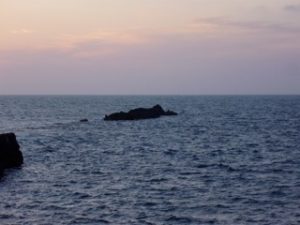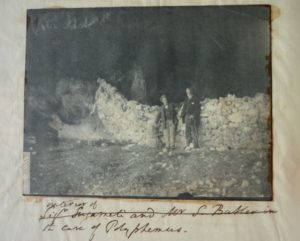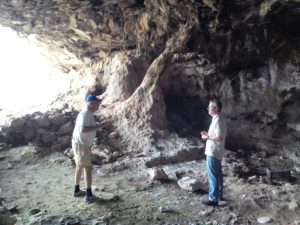Stillman, W.J. On the Track of Ulysses (1888)
(online text)
This book originated as articles in which Stillman describes his travel in the Ionian Sea, tracing the geography that he believes Homer know by autopsy. Stillman considers the Odyssey “not only the first history of travel, but the first geography, as it is doubtless a compendium of the knowledge of the earth’s surface at the day when it was composed.” The journey of Odysseus is localized on a map of the Mediterranean at the beginning of the book, but Stillman considers it mostly fairy tale, though he takes note of some ancient and standard localizations and hesitantly accepts a few as possible. His main concern is what Homer saw, and at the end Stillman concludes, “Homer does not seem to have any mental vision of the lands and islands of which Ulysses only speaks in his story—the lands of the Cimmerians, of the Laestrygonians, the Cyclops, the Lotophagi, the homes of Circe and Calpyso, are only heard of.” Stillman proposes that the Odyssey was not written ca. 850 BC (the date common in scholarship of his time), but before 1000 BC. Though academically based, the account records the personal experience of travel (by means of hired guides and crew, often portrayed as incompetent) in the course of one summer. A third chapter is on “The So-called Venus of Melos.”
Butler, Samuel The Authoress of the Odyssey (1897)
(online text)
Samuel Butler was a late-19th c. author (Erewhon, The Way of All Flesh) with contrarian views on evolutionary theory and Homeric studies. Besides producing a down-to-earth prose translation of the Odyssey, he argued in The Authoress of the Odyssey that a real-world Nausicaa, of Trapani on the west coast of Sicily, composed the Homeric epic. Though Butler spent time in Sicily, he did not try to recreate the journey of Odysseus. Yet his argument influenced many subsequent travel writers discussed here, particularly in his location of the Polyphemus episode on the west coast of Sicily (Favignana as ‘Goat Island’, a local cave as that of Polyphemus). He does not know of Stillman’s book but briefly refers to two modern authors (Stohlberg, Mure) who localized the Polyphemus episode in western Sicily. He also claims, without citation, ancient and medieval backing for this type of argument. Butler locates other episodes in the wanderings in or around Sicily—–see further discussion of his views in the section ‘Academic Bibliography.’
Samuel Butler’s thesis is the basis of the novel by R. Graves entitled Homer’s Daughter (1955). After a prologue that sets out the theory, the Greco-Sicilian princess Nausicaa tells her story.
- Rocks off the point at Trapani’s harbor: Butler saw in them the best candidate for Book 13’s petrification of the Phaeacian ship outside of the harbor of Scheria (which he linked to Trapani). photo: Jonathan Burgess
- Samuel Butler at his ‘cave of Polyphemus;’ photo pasted into mss. of The Authoress of the Odyssey. photo: Jonathan Burgess
- Jonathan Burgess at Butler’s ‘cave of Polyphemus,’ with local archaeology enthusiast Stefano Russo, Presidente of the “Centro Sikano-Svedese di Cultura” photo: Jane Aspinall
Halliburton, Richard The Glorious Adventure (1927)
This entertaining travel book employs Odysseus as a guide for escape and adventure. Halliburton not only follows the journey of Odysseus, but visits classical tourist sites, such as the Acropolis. Essayistic tangents about such matters as the Battle of Marathon and the start of the Olympic Games are provided. Most of the narrative focuses on his personal travel experiences. Some attention is given to the issue of localization of the journey of Odysseus, with much re-telling of the epic poem.
Bérard, Victor Dans le Sillage d’Ulysse (1933)
This book features the black and white photographs of F. Boissonnas [online here], which visualize the localization theories of Bérard, who in the late 1920’s published Les navigations d’Ulysse in 4 volumes (see ‘Academic Bibliography’). The beautiful photographs valuably preserve images of many places in relatively pristine state, before they were overrun by development and tourism. They also remind one of the experiential quality of Bérard’s research: he traveled by boat to the locales he discusses. Bérard’s arguments, rather wordy in the formal publications, are conveniently and concisely summarized in the endnotes. Bérard’s arguments are a mix of ancient localizations, original identifications based largely on topographical considerations, and a few ideas that do not continue to hold favor (linking craters in the volcanic area near the bay of Naples with single-eyed Cyclopes, for instance).
Schildt, Göran In the Wake of Ulysses (1953)
This charming travel book (translation by A. Blair) describes a 1950 sailing expedition by a Scandinavian husband and wife in a small boat (cf. Roth). They sail down the coast of Italy, to the Ionian Islands, through the strait of Corinth, about the Cyclades, and eventually to Crete. Despite the title, localization is not the purpose of the voyage (and so the book is not on our Table of Localizations). They do anchor near Monte Circeo (where the captain starts to read the Odyssey for the first time), and the Homeric story is remarked upon as they sail through the strait of Messina and visit Ithaca, but most Odyssean references are brief and offhand. The focus is on travel, which extends to mainland sites with the help of a Vespa stored below deck. Struggles with the ship’s engine and the fierce Meltemia winds provide drama; enjoyment of the climate and local culture provides the reader with much vicarious pleasure. Antiquity is a persistent theme, however; the author, a self-described “roving dilettante,” is well informed about ancient art and an intelligent observer of the archaeological sites at Olympia, Mycenae, Corinth, Epidauros, Athens, Delos, and Crete. Also fascinating are glimpses of a post-war Mediterranean world that is very different from ours; the author feels obliged to explain that pizza is “a kind of pasty peculiar to Campania,” and he expresses his frustration at finding only one hotel (with no guests) at Santorini.
Golding, Louis Good-bye to Ithaca (1955)
This book is an interesting mix of mythology, archeology, history, and travel writing, relating two major journeys (1916, 1953) inspired by Homer, as well as various other small trips over the years. The author describes in detail the scenery, atmosphere, and culture of all the places he visited. Golding is informed about the academic theories and archaeological discoveries of his day, but he does not provide much explanation for his localizations of the wanderings of Odysseus. Instead he relies on ancient identifications, local traditions, and the arguments of others. The narrative often moves back and forth between antiquity and the present, with a thematic focus on Homer and Odysseus. Golding believes that the journey may have been historic, or at least inspired by real places. His own journeys culminate with a visit, at long last, to Ithaca.
Beny, Roloff A Time of the Gods (1962)
Roloff Beny’s picture book results from a trip to the Mediterranean in 1962. Beny is inspired by Odysseus’ journey and employs the Odyssey as an organizational principle. Roloff describes this book as “a sequence of images made more plausible in their ordering by being based on the events of the Odyssey and the adventures of the hero.” He does not attempt to reconstruct Odysseus’ travels, but rather takes photos that are “put in order…to evoke vividly rather than accurately the personal vision inspired by Chapman’s Homer and the many later translations.” However, the influence of localization theories is sometimes apparent — for instance when he goes to the strait of Gibraltar in search of Calypso, following Bérard. Other locations include Djerba, Vulcano Island, the Straits of Messina, the Galli Islands, and Corfu. But Beny often employs an image merely to illustrate an episode, with no implication of localization (e.g., a shot of Argentario off the coast of Tuscany for the Goat Island passage). Places and museums are reached by station-wagon, a motor-driven calque, and a steamboat. This book is an attempt to visualize the entire Odyssey, not just Odysseus’ journey; the series of photographs therefore follow the order of the story, not Odysseus’ travels.
Bradford, Ernle Ulysses Found (1963)
In Ulysses Found, Bradford explores Odysseus’ voyage by combining extensive sea-faring experience in the Mediterranean with a solid education in Classics. Winds, currents, speed, and distance are calculated by Bradford in order to establish the route of Odysseus. Bradford views Odysseus as an ancient Columbus, though he allows that the epic may compile second-hand reports of Greek exploration of the western Mediterranean. Traditional interpretations of Odysseus’ journey, including those from antiquity, are evaluated and often defended. The reasoning is extensive and detailed, if not always persuasive. The Odyssey, which Bradford in his youth read in Greek, is quoted extensively, though sometimes interpreted rather literally. One of the outstanding examples of its genre, Ulysses Found at times seems to conflate reality with myth. An anecdote about once hearing odd sounds at night in the vicinity of the Galli Islands, deemed “silly” by Gall, is a memorable example of Bradford’s occasional relation of travel experience. But on the whole this is an academic exercise, compiling observations made in the course of much sailing, rather than an account of a single trip.
A visually pleasing video made by CBC news in the 60s (VHS format), entitled The Search for Ulysses, features Bradford, with Charles Kuralt; James Mason narrating select passages from the Odyssey. Bradford is shown sailing to the locations discussed in his book and is heard deriding the limited insight of desk-bound academics. In a cameo Lawrence Durrell disputes Bradford’s localization on the west side of Corfu, stating that he has built his house at the beach upon which Odysseus washed up on the east side—–and what’s more that he has discovered the ruins of the Phaeacian palace above in the hills!
Lessing, Erich The Voyages of Ulysses. A Photographic Interpretation of Homer’s Classic (1965)
The preface describes the book as a “imaginary museum” of the journey of Odysseus. The largest section consists of photographs of art and Mediterranean scenery by Lessing, who traveled to museums and locales associated with the journey of Odysseus. Selections from T.E. Shaw’s translation of the Odyssey are interspersed among the photographs. One chapter consists of selections from Schliemann’s book on Ithaca; another by H. Sichtermann discusses Odyssean themes in art; a third by C. Kerényi analyzes “Ulysses.” At the back is an index of the photos with annotations by Cornelia Kerenyi. It is a concise introductory essay by the French journalist Michel Gall that presents an argument for localizaton of the journey (which we have used for our Table of Localizations). Gall and Lessing for the most part follow the arguments of V. Berard, though Gall occasionally critically comments on ancient localizations as well as the ideas of Berard and Bradford. French and German sections are translated by Kevin Smyth.
A later abridged version, The Adventures of Ulysses. Homer’s Epic in Pictures (1970), drops the essays and adds a brief introductory essay by K. Kerenyi. Paraphrases of the Odyssey are here intermingled with the photos; localization is not addressed.
Obregon, E. Ulysses Airborne (1971)
The author travels with his wife as photographer in a small plane, tracing the journey of Odysseus. The photographs are interesting, and Obregon engagingly discusses his often idiosyncratic localizations. The argument often quotes from the Odyssey, with attention to Homeric description of topography. Reference to time and distance in the Homeric epic are considered typological and thus useless for localization.
Obregon is also the author of Beyond the Edge of the Sea: Sailing with Jason and the Argonauts, Ulysses, the Vikings, and Other Explorers of the Ancient World. (2001)
Severin, Timothy. The Ulysses Voyage: Sea Search For the Odyssey (1987)
Tim Severin traces Odysseus’ journey aboard the Argo, a modern twenty-oar replica of the mythological ship. The boat was actually constructed for a re-enactment of the journey of the Argo (reviewed under “Other Recreations of Ancient Journeys” on this website). Severin has in fact made a career out of following the journeys of real and mythical travellers. In this book Severin and his crew try to recreate the ancient experience of the sailing described in the Odyssey. His hypotheses about the journey of Odysseus are based on such criteria as topography, archaeology, toponymns, and local legend, but first-hand sailing experience is the key method. Ultimately Severin must fall back upon speculation; sudden insights repeatedly leap off the map at him. Non-traditional localization increases as Severin proceeds, and he eventually places many places within the Ionian sea around Ithaca. The emphasis on navigational autopsy (cf. Bradford, Cuisenier, Roth) provides a useful perspective, and as an engaging account of a single voyage the book succeeds as good travel writing.
Koromila, Marianna. In the Trail of Odysseus Trans. N. Clive (1994)
This book is not directly about the wanderings of Odysseus. It tells the story of Yiankos Danielopoulos, a Black Sea Greek who lived in the 20th century. In the preface the author suggests that his life was a “traveling epic” and rehearses the theory that Odysseus’ journey originally occurred in the Black Sea. “Hence the conclusion that the Odyssey re-echoes many of the experiences of the first Ionian sailors and merchants who dared to follow the course of the Argos [sic]…In fact, the Odyssey begins by reflecting Jason’s explorations.” It is argued that the Sirens are to be placed, at least symbolically, in the Sea of Marmara; Scylla, Charybdis, and the Clashing Rocks are to associated with the Bosphorus; the Black Sea represents the underworld.
Roth, Hal. We Followed Odysseus (1999)
Roth and his wife also attempt to trace the ancient voyage in their own boat. They rely heavily upon the traditional interpretation of the journey, as represented by Bradford, and contentedly sail from port to port. Roth assesses each site’s likelihood as the basis of a Homeric episode, but does not challenge the standard localizations. The author was a prolific chronicler of his sailing adventures with his wife around the world. This book records a single trip, which few of the books discussed here do (cf. Severin, Huler), and represents travel writing rather than academic study of localization theories.
Cuisenier, Jean Odysseus’ Navigations website (online text)
French anthropologist Jean Cuisenier’s web page summarizes his research projects, one of which is about ancient Greek sailing and the journey Odysseus. In addition to his anthropological interests, Cuisenier has decades of sailing experience in the Mediterranean and elsewhere (cf. Bradford, Severin). Between 1999 and 2001, he attempted to trace the sea routes of ancient Greek navigators, focusing on those described in the Odyssey. Cuisenier collaborated with specialists in a variety of fields, including archaeology, botany, and meteorology. The 1999 expedition to Sardinia, Sicily, and the Aeolian Islands studied the empirical knowledge of local fishermen, in the hopes that this shed light on ancient seafaring. The expedition in 2000 explored locations associated with the Trojan War.
The expeditions and their methodology are described, at great length, in le périple d’Ulysse (2003).
Prose, Francine. Sicilian Odyssey (2003)
Not only is the title suggestive, but the beginning of this book refers to Sicily as Homer’s “Island of the Sun.” But Homeric localization is not of primary interest in this travelogue. Culturally informed and entertaining, Scilian Odyssey recounts the author’s travels in Sicily. Prose does frequently mention Polyphemus and his connection to the area of Riviera dei Cyclopi (the river Acis, and the rocks of Acitrezza), and the arrival of Greeks in Sicily is briefly linked to the “same time Homer was dispatching Odysseus on his adventures” (22-23).
Huler, Scott No Man’s Lands: One Man’s Odyssey in the Odyssey (2008)
No Man’s Lands is a fine example of popular travel writing. The book uses the Odyssey as the framework for touristic excursions around the usual localized spots. Huler provides enthusiastic and introductory instruction on the Odyssey, though musings on the ethical lessons to be learned from Odysseus sometimes seem strained. However, the narrative provides many amusing details about his travel and the people he meets. It is the narrator’s personable character, which leads to much interaction with a wide variety of fellow travelers, that lies at the heart of the book. But Huler also displays some excellent writerly chops, notably a failed attempt to visit the crypt of the Church of the Immaculate Conception in Rome, which leads to an extended reminiscence of an earlier visit there (Huler’s “underworld”). In a 2008 issue of Phoenix, J. Burgess briefly notes that “this engaging book is really about low budget, improvisatory tourism, with some surprisingly Odyssean twists in the narrative structure. Though the journey of Odysseus is the organizing principle, its reality is not taken too seriously.”
Geisthovel, W., Homer’s Mediterranean (2010)
This is an attractively produced English translation (by A. Bell) of a German book on locales in the Iliad and Odyssey. The author primarily employs Die wirkliche Reise des Odysseus by Armin and Hans-Helmut Wolf and Celebrating Homer’s Landscapes by John V. Luce as his guides. He is well informed about current research in Homeric studies (e.g. Heubeck, Latacz, Korfmann), though he wears his learning lightly. He travels (apparently on different trips) from Turkey to Greece and the western Mediterranean, observing landscapes which he believes Homer knew, or at least his informants. Geisthovel is of the opinion that the journey reflects travel experiences of the Greeks, especially in the region of Sicily (cf. Butler). He quotes and insightfully discusses key passages from the Homeric epics. The author proves to be reliable in his information and sensible in his discussion of evidence and theories, if overly influenced by Armin Wolf. Superior to most other books considered here in both content and writing style, this book is an elegant and sometimes academically oriented travel guide. Impressively lyrical descriptions of place are periodically inserted into the text by this veteran travel writer, though the details of the author’s travel experiences are rather vague.




